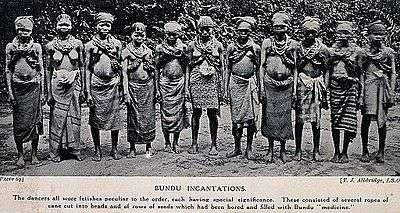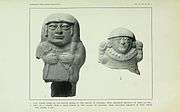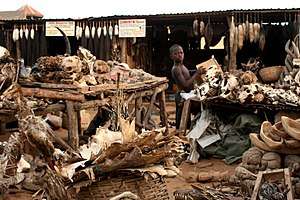Fetishism
A fetish (derived from the French fétiche; which comes from the Portuguese feitiço; and this in turn from Latin facticius, "artificial" and facere, "to make") is an object believed to have supernatural powers, or in particular, a human-made object that has power over others. Essentially, fetishism is the attribution of inherent value, or powers, to an object.

Historiography
The term "fetish" has evolved from an idiom used to describe a type of objects created in the interaction between European travelers and Africans in the early modern period to an analytical term that played a central role in the perception and study of non-Western art in general and African art in particular.
William Pietz, who, in 1994, conducted an extensive ethno-historical study[2] of the fetish, argues that the term originated in the coast of West Africa during the sixteenth and seventeenth centuries. Pietz distinguishes between, on the one hand, actual African objects that may be called fetishes in Europe, together with the indigenous theories of them, and on the other hand, "fetish", an idea, and an idea of a kind of object, to which the term above applies.[3]
According to Pietz, the post-colonial concept of "fetish" emerged from the encounter between Europeans and Africans in a very specific historical context and in response to African material culture.
He begins his thesis with an introduction to the complex history of the word:
My argument, then, is that the fetish could originate only in conjunction with the emergent articulation of the ideology of the commodity form that defined itself within and against the social values and religious ideologies of two radically different types of noncapitalist society, as they encountered each other in an ongoing cross-cultural situation. This process is indicated in the history of the word itself as it developed from the late medieval Portuguese feitiço, to the sixteenth-century pidgin Fetisso on the African coast, to various northern European versions of the word via the 1602 text of the Dutchman Pieter de Marees... The fetish, then, not only originated from, but remains specific to, the problem of the social value of material objects as revealed in situations formed by the encounter of radically heterogeneous social systems, and a study of the history of the idea of the fetish may be guided by identifying those themes that persist throughout the various discourses and disciplines that have appropriated the term.[4]
Stallybrass concludes that "Pietz shows that the fetish as a concept was elaborated to demonize the supposedly arbitrary attachment of West Africans to material objects. The European subject was constituted in opposition to a demonized fetishism, through the disavowal of the object."[5]
History
Initially, the Portuguese developed the concept of the fetish to refer to the objects used in religious practices by West African natives.[4] The contemporary Portuguese feitiço may refer to more neutral terms such as charm, enchantment, or abracadabra, or more potentially offensive terms such as juju, witchcraft, witchery, conjuration or bewitchment.
The concept was popularized in Europe circa 1757, when Charles de Brosses used it in comparing West African religion to the magical aspects of ancient Egyptian religion. Later, Auguste Comte employed the concept in his theory of the evolution of religion, wherein he posited fetishism as the earliest (most primitive) stage, followed by polytheism and monotheism. However, ethnography and anthropology would classify some artifacts of monotheistic religions as fetishes.
The eighteenth-century intellectuals who articulated the theory of fetishism encountered this notion in descriptions of "Guinea" contained in such popular voyage collections as Ramusio's Viaggio e Navigazioni (1550), de Bry's India Orientalis (1597), Purchas's Hakluytus Posthumus (1625), Churchill's Collection of Voyages and Travels (1732), Astley's A New General Collection of Voyages and Travels (1746), and Prevost's Histoire generale des voyages (1748).[6]
The theory of fetishism was articulated at the end of the eighteenth century by G.W.F. Hegel in Lectures on the Philosophy of History. According to Hegel, Africans were incapable of abstract thought, their ideas and actions were governed by impulse, and therefore a fetish object could be anything that then was arbitrarily imbued with imaginary powers.[7]
In the 19th and 20th centuries, Tylor and McLennan, historians of religion, held that the concept of fetishism fostered a shift of attention away from the relationship between people and God, to focus instead on a relationship between people and material objects, and that this, in turn, allowed for the establishment of false models of causality for natural events. This they saw as a central problem historically and sociologically.
Practice
The use of the concept in the study of religion derives from studies of traditional West African religious beliefs, as well as from Voodoo, which in turn derives from those beliefs.
Fetishes were commonly used in Native American religion and practices.[8] The bear represented the shaman, the buffalo was the provider, the mountain lion was the warrior, and the wolf was the pathfinder.[8]
Minkisi
Made and used by the BaKongo people of western Zaire, a nkisi (plural minkisi) is a sculptural object that provides a local habitation for a spiritual personality. Though some minkisi have always been anthropomorphic, they were probably much less naturalistic or "realistic" before the arrival of the Europeans in the nineteenth century; Kongo figures are more naturalistic in the coastal areas than inland.[3] As Europeans tend to think of spirits as objects of worship, idols become the objects of idolatry when worship was addressed to false gods. In this way, Europeans regarded minkisi as idols on the basis of false assumptions.
Europeans often called nkisi "fetishes" and sometimes "idols" because they are sometimes rendered in human form. Modern anthropology has generally referred to these objects either as "power objects" or as "charms".
In addressing the question of whether a nkisi is a fetish, William McGaffey writes that the Kongo ritual system as a whole,
bears a relationship similar to that which Marx supposed that "political economy" bore to capitalism as its "religion", but not for the reasons advanced by Bosman, the Enlightenment thinkers, and Hegel. The irrationally "animate" character of the ritual system's symbolic apparatus, including minkisi, divination devices, and witch-testing ordeals, obliquely expressed real relations of power among the participants in ritual. "Fetishism" is about relations among people, rather than the objects that mediate and disguise those relations.[3]
Therefore, McGaffey concludes, to call a minkisi a fetish is to translate "certain Kongo realities into the categories developed in the emergent social sciences of nineteenth century, post-enlightenment Europe."[3]
References
- T. J. Alldridge, The Sherbro and its Hinterland, (1901)
- Pietz, William (1988). The origin of fetishism: A contribution to the history of theory (Ph.D. diss.). University of California, Santa Cruz.
- MacGaffey, Wyatt (Spring 1994). "African objects and the idea of fetish". RES: Anthropology and Aesthetics. 25: 123–131.
- Pietz, William (Spring 1985). "The Problem of the Fetish, I". RES: Anthropology and Aesthetics. The President and Fellows of Harvard College acting through the Peabody Museum of Archaeology and Ethnology (9): 5–17. JSTOR 20166719.
- Stallybrass, Peter (2001). Daniel Miller (ed.). Consumption : critical concepts in the social sciences (1. publ. ed.). London: Routledge. ISBN 0415242673.
- Pietz, William (Spring 1987). "The Problem of the Fetish, II: The Origin of the Fetish". RES: Anthropology and Aesthetics (13): 23–45. JSTOR 20166762.
- MacGaffey, Wyatt (1993). Astonishment & Power, The Eyes of Understanding: Kongo Minkisi. National Museum of African Art.
- "Animals: fact and folklore," New Mexico Magazine, August 2008, pp. 56-63, see New Mexico magazine website.
See also
External links
- The Catholic Encyclopaedia: Fetishism
- Andrew Lang, Fetishism and Spiritualism, The Making of Religion, (Chapter VIII), Longmans, Green, and C°, London, New York and Bombay, 1900, pp. 147–159.

